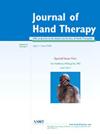The efficacy of Mulligan mobilization and corticosteroid injection on pain, functionality, and proprioception in rotator cuff tears: A randomized controlled trial
IF 1.8
4区 医学
Q2 ORTHOPEDICS
引用次数: 0
Abstract
Background
Treatment of rotator cuff (RTC) tears commonly involves manual therapy, exercise, and injection methods. These treatments are typically administered together as components of a physical therapy intervention. However, it is not known which intervention is more effective.
Purpose
The objective of this study was to examine the impact of mobilization with movement (MWM) mobilization, a technique from Mulligan approaches, and corticosteroid (CS) injection on pain, functionality, and proprioception in cases of RTC tears.
Study Design
This was a single-blinded randomized clinical trial.
Methods
Participants with RTC tears (n = 60) were divided into Mulligan mobilization (MM) and CS groups. The participants in the MM group performed mobilization with movement and a conventional exercise program; the CS group received a CS injection in addition to conventional exercises. The Visual Analog Scale, The Disabilities of the Arm, Shoulder, and Hand questionnaire, active range of motion (AROM), and joint position sense (JPS) were evaluated. The outcomes were analyzed using effect size, minimum clinically important difference, minimal detectable change, Wilcoxon test, and Mann-Whitney U test.
Results
Both groups significantly improved in all measured outcomes at 3 weeks. The MM group showed significantly better (p < 0.05, Cohen d range 0.82-3.2) results in pain, AROM (Flexion, abduction, extension, external rotation, internal rotation), and proprioception (30° and 60° of flexion and abduction). Between-group differences in AROM were also clinically meaningful as they exceeded their MDC90 and minimum clinically important difference values.
Conclusions
Although both of these treatment methods may be successful in the short-term management of chronic RTC, the MM approach combined with conventional exercises seems to be a more effective approach for improving shoulder pain, function, and proprioception in this patient population.
Clinical Trial Number
NCT05933382
Mulligan活动和皮质类固醇注射对肩袖撕裂患者疼痛、功能和本体感觉的疗效:一项随机对照试验。
背景:肩袖撕裂的治疗通常包括手工治疗、运动和注射方法。这些治疗通常作为物理治疗干预的组成部分一起进行。然而,目前尚不清楚哪种干预措施更有效。目的:本研究的目的是检查运动动员(MWM)动员,Mulligan入路技术和皮质类固醇(CS)注射对RTC撕裂患者疼痛、功能和本体感觉的影响。研究设计:这是一项单盲随机临床试验。方法:60例RTC撕裂患者分为Mulligan动员(MM)组和CS组。MM组的参与者在运动和常规运动项目中进行动员;CS组在常规运动的基础上注射CS。评估视觉模拟量表、手臂、肩部和手部残疾问卷、主动活动范围(AROM)和关节位置感(JPS)。结果采用效应量、最小临床重要差异、最小可检测变化、Wilcoxon检验和Mann-Whitney U检验进行分析。结果:两组在3周时的所有测量结果均有显著改善。MM组表现明显较好(p < 90),且具有最小临床重要差异值。结论:虽然这两种治疗方法在慢性RTC的短期治疗中可能都是成功的,但MM入路结合常规运动似乎是改善该患者群体肩痛、功能和本体感觉的更有效方法。临床试验号:NCT05933382。
本文章由计算机程序翻译,如有差异,请以英文原文为准。
求助全文
约1分钟内获得全文
求助全文
来源期刊

Journal of Hand Therapy
医学-外科
CiteScore
3.50
自引率
10.00%
发文量
65
审稿时长
19.2 weeks
期刊介绍:
The Journal of Hand Therapy is designed for hand therapists, occupational and physical therapists, and other hand specialists involved in the rehabilitation of disabling hand problems. The Journal functions as a source of education and information by publishing scientific and clinical articles. Regular features include original reports, clinical reviews, case studies, editorials, and book reviews.
 求助内容:
求助内容: 应助结果提醒方式:
应助结果提醒方式:


